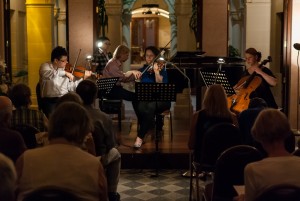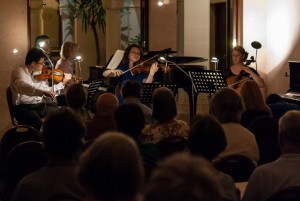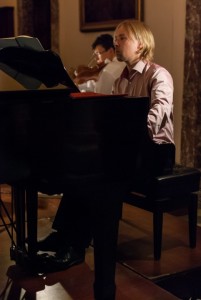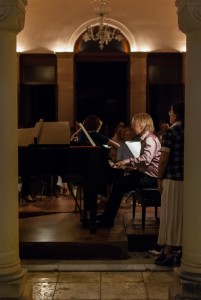A stunning performance by Status Piano Quartet
On Wednesday evening, Status Piano Quartet from Finland, comprised of Jaso Sasaki (Violin), Barbora Hilpo (Viola), Saara Iida-Vilhelmina Laine (Violoncello), and Marko Hilpo (Pianoforte) regaled a packed Aula Mgr G. Farrugia with a tremendously vibrant and professional performance of Mozart’s Piano Quartet no. 2 in Eb Major K.493 and Brahms’ Piano Quartet no. 3 in C Minor op. 60. Maturity, intelligence and musicality were the hallmarks of this performance, one that could have gone on for much longer than the 80mins or so of its duration.
Starting with the Mozart, this was an exercise in refinement and elegance. The first movement, Allegro, opens less ominously than that of the earlier Quartet, allowing delicate contrast between the pianoforte and the other instruments, closely integrated in the chamber-music texture of the work. The pianoforte begins the second subject, which is soon taken from it by the violin, which has more to add, before the exposition is completed. The development made further use of the figure that opens the subsidiary material, before the recapitulation. The slow movement is an A flat major Larghetto, its gentle principal theme introduced by the pianoforte. The tripartite structure again opened up room for subtle interplay between the instruments, with the pianoforte never allowed to overwhelm its partners. The Quartet ended with an Allegretto, a Rondo with rhythmic variety in its contrasting episodes, rich in its melodic material, and equally demanding as its predecessor. The legato playing was superbly handled by all instruments, most specially by the pianist, and the tone quality of the three string instruments was nothing short of brilliant.
Brahms is never easy but always infinitely exciting for both performers and audience. Rich, deep, lush – this is the texture one normally associates with a Brahms work and the evening’s performance of his Quartet no. 3 in C Minor op. 60 was nothing short of formidable. In its own way it is a slightly strange work in that it often (mis?)leads to places it never intends to go but that does not detract from the fact that it is a monumental work from a structural and musical point of view.
As is the case with much of Brahms’ chamber and symphonic work, this Quartet reflects the turbulent and vacillating self-doubts that Brahms felt so deeply. Indeed, little more darkly oppressive movements than the first exist anywhere else in Brahms’ chamber output. It shimmered with uneasy feelings, excruciating doubt and moments of exhilaration – in equal measure – and these qualities were at the forefront of the ensemble’s interpretation. Formidable, strong, tender and laden with pathos, this first movement, as well as the subsequent Scherzo, truly showed up the very high quality of these young players who, while they evidently manifested their brilliant prowess as excellent soloists in their own right, worked so well as a team. There is no other way such a work could have taken off if this were not the case.
The third movement, an Andante in E major is certainly one of the most beautiful, typically Brahms – sensuous, warm, and rich. The seductive tones of the viola came out in all their magic, while the very beautiful tones of the cello were simply exquisite. The violin had some difficult passages to tackle and these were managed with confidence and panache. The final Allegro came across as forceful, demonic at times and utterly beautiful. The pianist proved to be the pivot around which this movement turned. He is a musician of the finest order! Again, special credit goes to the ensemble for rising to such a big occasion.
Such concerts are a rarity to come by, especially in tiny Gozo. It was a dazzling and scintillating performance that will long be remembered. Most of the patrons who were simply enthralled by the performance all expressed how privileged they were to be given such wonderful opportunities free of charge. All of us know how much we have to pay to listen to such wonderful music when we are away from the island!
Thank you, Status, and we hope to have more of you sooner rather than later!








